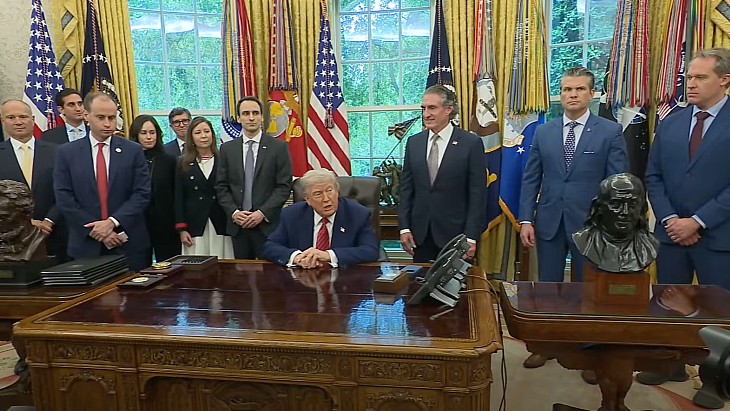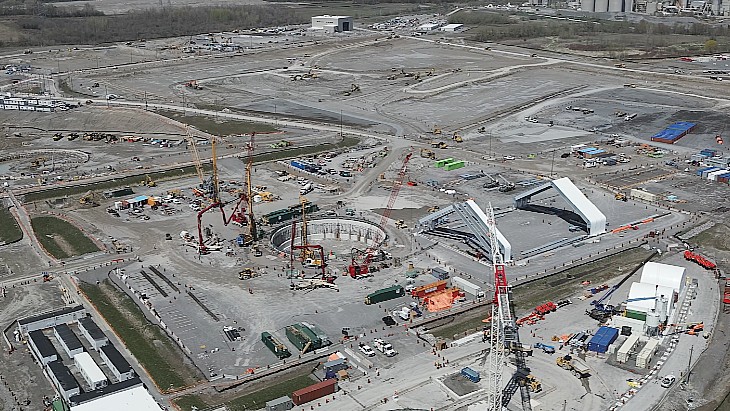KSTAR unveiled
Friday, 14 September 2007
 South Korea's fusion test-bed, KSTAR, is complete and was unveiled on 14 September.
South Korea's fusion test-bed, KSTAR, is complete and was unveiled on 14 September. The superconducting tokamak fusion reactor will contribute to a global project for clean energy.
South Korea's fusion test-bed, KSTAR, is complete and was unveiled on 14 September.
South Korea's fusion test-bed, KSTAR, is complete and was unveiled on 14 September. The superconducting tokamak fusion reactor will contribute to a global project for clean energy.
 The Korea Superconducting Tokamak Advanced Reactor was built for a cost of $3 billion. The machine was unveiled today to an assembly of 400 nuclear fusion scientists, diplomats and guests by proud owners, South Korea's National Fusion Research Institute (NFRI), based at Daejon, 160 km south of Seoul. The project also involved the Korea Atomic Energy Research Institute (Kaeri) and the Pohang University of Science and Technology.
The Korea Superconducting Tokamak Advanced Reactor was built for a cost of $3 billion. The machine was unveiled today to an assembly of 400 nuclear fusion scientists, diplomats and guests by proud owners, South Korea's National Fusion Research Institute (NFRI), based at Daejon, 160 km south of Seoul. The project also involved the Korea Atomic Energy Research Institute (Kaeri) and the Pohang University of Science and Technology.
The fusion research reactor, which took 12 years to build, is the first in the world to feature a fully superconducting magnet system with a central solenoid, toroidal and poloidal field coils. It measures 8.6 m high, and 8.8 m in diameter.
NFRI President Jae In Shin said that KSTAR was the centrepiece of a government strategy to "vault the Korean research effort to the forefront of fusion science and technology."
Tokomak-design reactors like KSTAR use magnetism to contain a toroidal-shaped plasma at temperatures of up to 300 million degrees C. Despite this temperature it is necessary to cool superconducting magnets to -269 degrees C. Inside the plasma, a few grams of deuterium and tritium atoms are stripped to the nucleii, which fuse to release energy. It is hoped that this form of nuclear energy could one day be used to generate electricity, but maintaining a steady plasma has proven very difficult. KSTAR should be able to maintain a steady-state plasma for up to 300 seconds.
KSTAR is also the name for a four-to-five-year research program which uses the reactor facility. Commissioning begins immediately, first plasma at KSTAR is expected next year.
Besides this program, scientific results from KSTAR will contribute to the Iter project which has begun in France. Iter will be a huge 500 MWt tokamak, intended to be the proving ground for its successor, a prototype fusion power station already named Demo which researchers hope to begin constructing in 2025.
Further information
Korea Atomic Energy Research Institute
National Fusion Research Institute
Pohang University of Science and Technology
WNA's Nuclear Fusion Power information paper
WNN: Fusion project implementation agreed
 South Korea's fusion test-bed, KSTAR, is complete and was unveiled on 14 September.
South Korea's fusion test-bed, KSTAR, is complete and was unveiled on 14 September. The Korea Superconducting Tokamak Advanced Reactor was built for a cost of $3 billion. The machine was unveiled today to an assembly of 400 nuclear fusion scientists, diplomats and guests by proud owners, South Korea's National Fusion Research Institute (NFRI), based at Daejon, 160 km south of Seoul. The project also involved the Korea Atomic Energy Research Institute (Kaeri) and the Pohang University of Science and Technology.
The Korea Superconducting Tokamak Advanced Reactor was built for a cost of $3 billion. The machine was unveiled today to an assembly of 400 nuclear fusion scientists, diplomats and guests by proud owners, South Korea's National Fusion Research Institute (NFRI), based at Daejon, 160 km south of Seoul. The project also involved the Korea Atomic Energy Research Institute (Kaeri) and the Pohang University of Science and Technology.The fusion research reactor, which took 12 years to build, is the first in the world to feature a fully superconducting magnet system with a central solenoid, toroidal and poloidal field coils. It measures 8.6 m high, and 8.8 m in diameter.
NFRI President Jae In Shin said that KSTAR was the centrepiece of a government strategy to "vault the Korean research effort to the forefront of fusion science and technology."
Tokomak-design reactors like KSTAR use magnetism to contain a toroidal-shaped plasma at temperatures of up to 300 million degrees C. Despite this temperature it is necessary to cool superconducting magnets to -269 degrees C. Inside the plasma, a few grams of deuterium and tritium atoms are stripped to the nucleii, which fuse to release energy. It is hoped that this form of nuclear energy could one day be used to generate electricity, but maintaining a steady plasma has proven very difficult. KSTAR should be able to maintain a steady-state plasma for up to 300 seconds.
KSTAR is also the name for a four-to-five-year research program which uses the reactor facility. Commissioning begins immediately, first plasma at KSTAR is expected next year.
Besides this program, scientific results from KSTAR will contribute to the Iter project which has begun in France. Iter will be a huge 500 MWt tokamak, intended to be the proving ground for its successor, a prototype fusion power station already named Demo which researchers hope to begin constructing in 2025.
Further information
Korea Atomic Energy Research Institute
National Fusion Research Institute
Pohang University of Science and Technology
WNA's Nuclear Fusion Power information paper
WNN: Fusion project implementation agreed
Most Read
_92619.jpg)
Deep Atomic launches SMR for data centres
Friday, 25 October 2024

Czech Republic selects Rolls-Royce SMR for small reactors project
Thursday, 19 September 2024
_84504.jpg)
Framatome to share fast reactor experience with Japan
Friday, 6 December 2024

Iran outlines nuclear energy plans, including first concrete for Bushehr 3 this year
Friday, 27 September 2024
Podcasts & Features
Podcast: President Trump's nuclear announcements
Podcasts & Features Thursday, 29 May 2025







